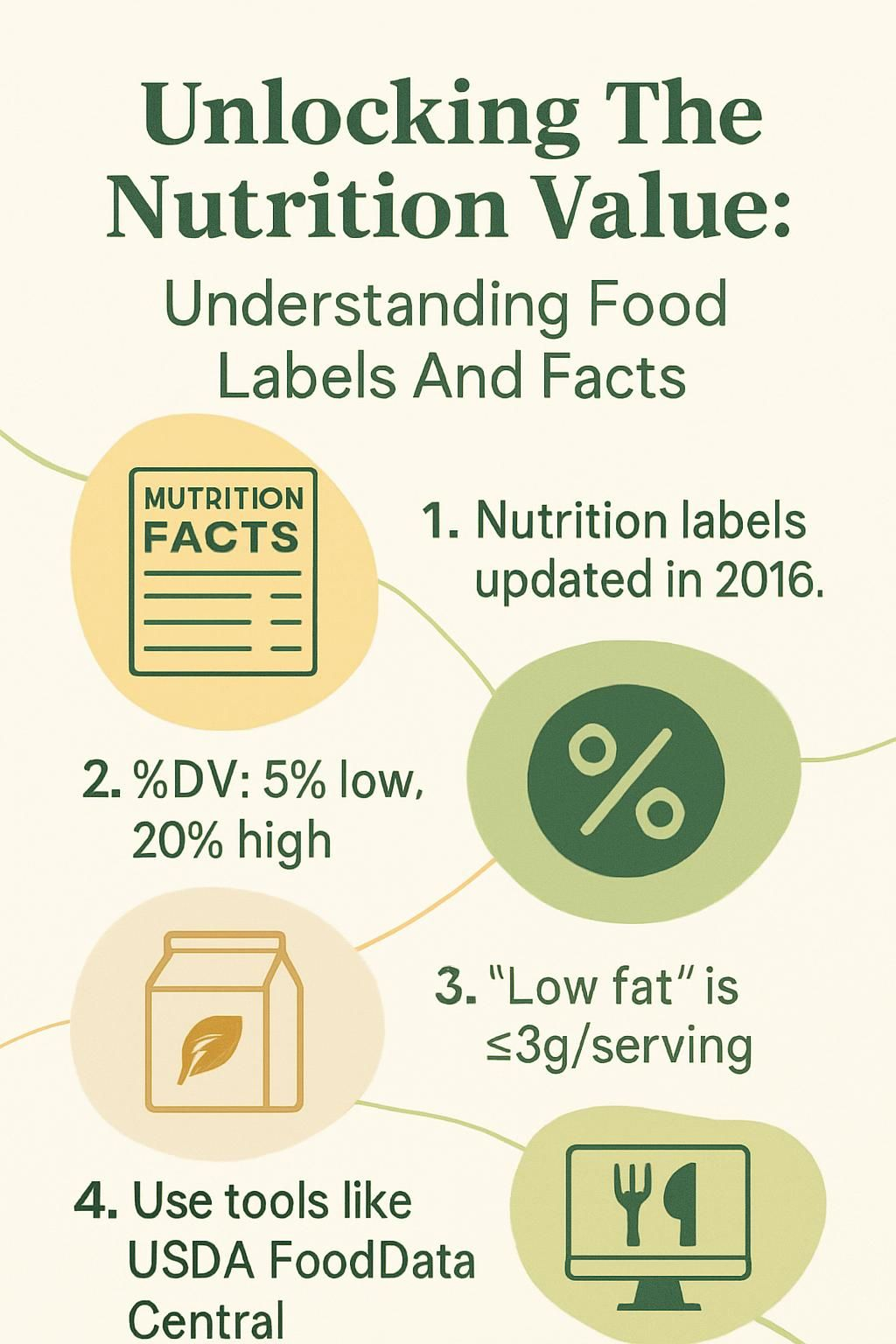Unlocking The Nutrition Value: Understanding Food Labels And Facts
Our Nutrition Assistant AI Suite will transform your body. You will lose fat, get toned, and build muscle. Gain confidence and optimal health.
Seeing a nutrition facts label can feel confusing at first. Still, understanding the numbers helps you choose foods that fit your goals for weight, energy, and health. Research from the FDA and USDA shows that label reading supports better decisions and a healthier diet.
This guide explains each part of the nutrition facts label in clear steps. You will learn how to use serving size, calories, Daily Value, and key nutrients to plan smart meals. Use these facts to make choices that support your daily nutrient intake and long-term health.
Key Takeaways
- Most packaged foods regulated by the FDA must show a Nutrition Facts label. The 2016 update added realistic serving sizes and clearer percent Daily Value (%DV) based on a 2,000-calorie diet.
- Labels list calories, protein, carbohydrates, fat, added sugars, dietary fiber, select vitamins, and minerals such as iron, calcium, and potassium.
- As a guide, 5% DV or less is low and 20% DV or more is high. Comparing %DV across products helps you meet goals or manage conditions.
- Common claims are regulated: “low fat” means 3 grams or less per serving, “reduced sodium” means at least 25% less sodium than the regular product, and “sugar-free” means under 0.5 grams per serving.
- Trusted tools, including USDA FoodData Central and Nutritionix, offer searchable nutrition databases to compare calories, macronutrients, vitamins, and minerals.

What is a Nutrition Facts Label?

Understanding a nutrition facts label makes comparison simple. Every FDA-regulated packaged food or drink includes this panel. It lists serving size, servings per container, calories, and macronutrients, which are protein, carbohydrates, and fat. It also shows added sugars, dietary fiber, and key vitamins and minerals such as vitamin D, calcium, iron, and potassium.
In 2016, the FDA redesigned the label to reflect how people actually eat. The update added bigger type for calories, a new line for added sugars, and clearer %DV values. All values are based on a 2,000-calorie diet, which is a general reference, not a rule for everyone. You can explore the Interactive Nutrition Facts Label to learn tips for healthy eating.
I once compared two breakfast cereals using %DV. One brand delivered more fiber with less added sugar, so it was the better pick for my morning routine. The label helped me see the difference in seconds.
The facts apply to the serving size shown. Cooked weights can differ from raw weights; always match your portion to the label before deciding.
Why Should I Understand Food Labels?
Food labels give clear nutrition information so you can make informed choices. Reading them helps you understand what you eat, plan meals, and reach personal goals for health.
How do food labels help me make informed choices?
Labels show serving size, calories, and a macronutrient breakdown for each product. You also see added sugars, dietary fiber, vitamins, minerals, and the Percent Daily Value. These details make quick comparisons easier across brands and flavors.
The %DV shows how much one serving contributes to your daily needs on a 2,000-calorie diet. This helps if you track intake to lower risks linked to obesity, hypertension, or cardiovascular disease. Labels draw on FDA rules and data used by the USDA, so the information is consistent across the food supply.
I always check labels for items like yogurt and cereal. Comparing numbers helps me pick options with less added sugar and more fiber. As the FDA says:
The label makes it easier for you to compare similar foods to determine which is a healthier choice.
How can food labels assist in managing health conditions?
Labels list sodium, saturated fat, and added sugars per serving, which supports daily targets. This matters if you manage blood pressure, cholesterol, or blood sugar. The %DV makes it simple to compare brands and serving sizes.
For diabetes, the added sugars line helps track total carbohydrate intake. I showed my aunt how to scan yogurt labels after her diagnosis. She began choosing lower sugar cups with more protein, and her meals felt steadier.
Health professionals often use label literacy in counseling, supported by FDA and USDA resources. Accurate numbers help you plan meals and reduce risk for hypertension or high LDL cholesterol.
How do food labels support a balanced diet?
Serving size and servings per container help with portion control. Matching your portions to the label keeps you aligned with Dietary Reference Intakes, also called DRIs.
The macronutrient lines for protein, carbs, and fat show how a food fits your goals and activity level. Labels must also list vitamin D, calcium, iron, and potassium. Other vitamins and minerals may appear if the maker chooses to include them or if the food is fortified.
Labels do not list individual amino acids, the building blocks of protein. Still, checking total protein grams helps you balance plates with fruits, vegetables, and grains.
Main Sections of a Nutrition Facts Label
Each section of the label gives facts that guide your choices. Understanding these parts helps you match foods to your health goals.
Serving size and servings per container
Serving size reflects what people typically eat at one time. It is not a recommendation. The 2016 update set sizes that better match real habits, which makes planning easier.
If a label states “serving size: 2/3 cup” and “8 servings per container,” all calories and %DV refer to that 2/3 cup. Eating two servings doubles every number listed.
Check both serving size and servings per container to avoid surprises. I once grabbed a small bag of veggie chips that looked like one portion. The label showed three servings. Finishing the bag tripled my sodium and fat without me noticing at first.
Calories and calorie breakdown
After serving size, check calories next. Since 2016, calories appear in bold for easy scanning. The number is per serving, matched to the listed portion, whether raw or cooked.
Calorie density varies widely. For example, a cup of watermelon has about 46 calories, while a tablespoon of honey has around 64 calories. Labels use a 2,000-calorie reference for general advice. Your needs may differ.
Use this information to adjust portions, support weight goals, or manage conditions like diabetes or heart disease. I compare labels before I add items to the cart for my family, including meals for kids and older relatives.
Macronutrients: Protein, Carbohydrates, Fats
Macronutrients provide energy and support growth and repair. The label shows grams per serving for protein, carbohydrates, and fats.
- Protein builds muscle, repairs tissue, and supports immunity. Check grams per serving to meet your target for the day.
- Total carbohydrates include starches, sugars, and fiber. For example, 100 grams of cherries contain about 12 grams of carbs.
- Fats provide lasting energy and support cells. Labels show total fat, saturated fat, and trans fat. A cup of whole milk has about 8 grams of fat.
- Calorie balance helps you fit macronutrients into your day. The 2,000-calorie reference makes comparisons simple across products.
- Food trackers use USDA data to report macros. These tools help you assess choices and plan smarter meals.
- Managing carbs can help with diabetes or weight concerns. Fiber aids digestion. Cucumbers offer about 0.5 grams of fiber per 100 grams.
- Smart picks include higher protein and lower added sugar options. These choices align better with dietary guidelines.
Micronutrients: Vitamins and Minerals
Vitamins and minerals support bone health, immunity, nerves, and energy use. The label highlights key nutrients that most people need each day.
- FDA rules require listing vitamin D, calcium, iron, and potassium. Other vitamins and minerals may be listed, especially if a food is fortified.
- The Percent Daily Value shows how much one serving contributes toward a 2,000-calorie daily goal.
- Nutrition apps and databases let you compare foods by highest or lowest levels of specific nutrients.
- Many foods are fortified or enriched, like vitamin D in milk or iodine in salt, to support public health.
- If your diet lacks certain nutrients, labels can help you spot good sources quickly.
- Drinks can help too. Orange juice often provides vitamin C. Dairy supplies calcium and vitamin D.
- I tracked my iron intake after a low lab result. Choosing iron-rich foods made rebuilding levels easier.
Added sugars and dietary fiber
Since 2016, labels show total sugars and a separate line for added sugars. This change helps you see how much sugar was added during processing.
Dietary fiber appears in grams and as %DV. Higher fiber supports digestion and helps you feel full. Lower added sugars can support steady energy and weight control.
I compared two yogurts using these lines. The lower sugar option with more fiber kept breakfast satisfying without a sugar crash.
Daily Value percentages
%DV shows how much a nutrient in one serving contributes to your day based on a 2,000-calorie diet. This makes it easy to see if a food is high or low in a nutrient.
As a rule of thumb, 5% DV or less is low. About 20% DV or more is high. FDA rules require %DV for fat, saturated fat, cholesterol, sodium, total carbohydrates, dietary fiber, protein, and specific vitamins and minerals.
Use the Interactive Nutrition Facts Label tool to practice reading DV. The more you compare, the more confident you will feel choosing foods that support your goals.
How Do I Use Nutrition Facts Labels?
Nutrition Facts Labels help you track minerals and macronutrients day to day. They also show how a food fits into your %DV targets.
How to compare similar products using labels
Labels give you the numbers you need to make fast, accurate choices. Use this checklist in the store or at home.
- Match serving sizes. Compare products using the same serving amount.
- Scan calories per serving. Pick the option that fits your energy needs.
- Check macronutrients. Choose higher protein if you want longer fullness.
- Review added sugars. Less added sugar often supports better health.
- Compare %DV for fiber, calcium, iron, and vitamins. Choose foods that help you meet your daily needs.
- Look at sodium. “Reduced sodium” usually means at least 25% less than the regular version.
- Scan ingredients for fortification or enrichment, like added vitamin D or iron.
- Use tools such as USDA FoodData Central to compare brands before you shop.
These steps help you balance meals and manage conditions with confidence.
How to assess nutrient intake from labels
Use the label to see how each serving adds to your daily totals. Small checks add up to better habits.
- Start with serving size. All data on the panel matches that portion.
- Use %DV to measure progress. For instance, 20% DV of fiber equals one-fifth of your daily goal.
- Add up grams of protein, carbs, and fat across your meals.
- Compare added sugars to your targets. Many experts advise less than 10% of daily calories from added sugars.
- Watch sodium and saturated fat to support heart health.
- Log servings in an app like MyFitnessPal to view totals over time.
- Check %DV for vitamins and minerals to reach at least 100% for essentials such as calcium, iron, and vitamin C.
Portions matter. Adjusting them helps you hit your goals more consistently.
How to adjust portions to meet dietary goals
Portion changes can shift calories and nutrients without changing your whole menu. Labels and apps make the math simple.
- Use the serving size as your baseline for measuring portions.
- Scale portions in USDA FoodData Central or tracking apps to update calories and macros.
- Enter recipes so the app reflects your specific ingredients and amounts.
- Use %DV to adjust. Increase or reduce portions to meet targets for sodium, fiber, or added sugars.
- Match portions to your energy needs. Teens or athletes may need more, older adults may need less.
- Split multi-serving packages into single servings to avoid overeating.
- Balance fiber and added sugars to support heart and blood sugar goals.
What Do Common Food Label Terms Mean?
Food packages use regulated terms that guide your choices. Understanding them keeps expectations realistic and helps you use the %DV correctly.
What do low fat, reduced sodium, and sugar-free mean?
These claims follow specific FDA definitions. “Low fat” has 3 grams of fat or less per serving. “Reduced sodium” has at least 25% less sodium than the regular product. “Sugar-free” has less than 0.5 grams of sugars per serving.
Nutrition trackers, including those that organize DV (video format), let you filter by these claims. I use these tools to find items that align with my goals, like cutting added sugars or supporting healthy cholesterol.
What is the difference between organic and non-organic labels?
Organic foods must meet USDA certification standards. Farmers limit synthetic pesticides and fertilizers and avoid most genetically engineered seeds. Only approved products may display the USDA Organic seal.
Non-organic foods can use conventional methods, including synthetic chemicals. Tools such as USDA FoodData Central show both organic and non-organic items. I once logged an organic apple and a regular apple to compare entries in the Foundation and Branded Foods databases. The nutrition was similar, but I liked seeing the growing practice and ingredient details.
What are fortified and enriched products?
Fortified foods have vitamins or minerals added that were not present in meaningful amounts before. Examples include vitamin D in milk and added iron or B vitamins in cereal. Enriched foods add back nutrients lost during processing, like B vitamins and iron in many white breads.
Any added nutrients appear on the Nutrition Facts panel, as required by federal standards. USDA databases document these values so consumers and professionals can verify them. I compared regular rice with enriched rice and chose the one with listed folic acid to better fit my family’s needs.
Tools for Understanding Nutrition Better
Reliable tools can speed up label reading, support tracking, and guide smarter choices at home and on the go.
What online nutrition databases are available?
The USDA National Nutrient Database is a trusted reference for calories, macros, vitamins, and minerals. You can search by food name or item code.
NutritionValue.org lets you look up the nutrition content of packaged and fresh foods with a simple search bar. Nutritionix also provides detailed data, including restaurant items from over 25,000 locations. My dietitian suggested Nutritionix during meal planning. It helped me compare menu items side by side before ordering.
How to use USDA FoodData Central?
Type a food name, brand, or UPC into the search box. For example, search “apples” or enter the code 071464017187 for precise results. Choose the correct item from the list.
Then review nutrients like calories, protein, carbohydrates, fats, vitamins, and minerals. The platform contains several databases, including Standard Reference, Food and Nutrient Database, Foundation Foods, and Branded Foods. Each entry shows serving size and detailed values. For packaged foods, the UPC helps you find brand-specific details quickly.
Which nutrition tracking apps are useful?
Nutritionix Track lets you log meals and analyze your nutrition fast. It includes restaurant calculators to estimate values when eating out.
MyFitnessPal is another popular option. You can scan barcodes and compare products using a large database. Tracking meals raised my awareness of portion size and added sugars. Consistent logging nudged me toward lower sodium and higher fiber choices over time.
What is the Nutritional Value of Common Foods?
Knowing the nutritional value of everyday foods helps with quick swaps and better planning. Use trusted data to compare options that fit your goals.
Nutrition facts for fruits: Bananas, Watermelon, Cherries
Bananas, watermelon, and cherries are easy to find and simple to compare using NutritionValue.org or USDA data.
- Bananas: About 105 calories per medium fruit, 27 grams of carbs, roughly 3 grams of fiber, and more than 400 milligrams of potassium. They also provide vitamin C and vitamin B6.
- Watermelon: About 46 calories per cup and roughly 92% water. One serving provides about 12 grams of carbs and helpful amounts of vitamins A and C.
- Cherries: Around 87 calories per cup with about 22 grams of carbs. They supply potassium, vitamin C, and antioxidants like anthocyanins.
- USDA FoodData Central shows bananas as a top fruit source of potassium. Watermelon supports hydration. Cherries stand out for antioxidant content.
- NutritionValue.org can compare these fruits side by side for calorie density and key micronutrients.
- Bananas work well after exercise because they help replace potassium. Watermelon makes a refreshing snack in hot weather.
- Check labels on pre-cut fruit cups for serving size and total sugars before buying.
Nutrition facts for vegetables: Cucumbers, Mushrooms, Corn
Vegetables add fiber and essential micronutrients. USDA FoodData Central and NutritionValue.org provide detailed profiles to support smart choices.
- Cucumbers: About 16 calories per cup of slices. They are about 95% water and supply small amounts of vitamin K, potassium, and magnesium.
- Mushrooms: A good source of B vitamins like riboflavin and niacin. One cup of raw white mushrooms has about 15 calories and more than 20% DV for selenium.
- Corn: Higher in carbs than most non-starchy vegetables. One cup cooked has about 123 calories, plus fiber, vitamin C, and folate. It also contains beneficial carotenoids such as lutein.
- USDA Foundation Foods lists proteins, minerals such as calcium and iron, and trace nutrients for deeper comparisons.
- Sorting tools help you see differences fast. Mushrooms often rank high for selenium, while corn offers more carbohydrates.
- Use %DV to pick vitamin-rich choices in the store or during meal prep.
- I swapped corn for mushrooms in lunch bowls to lower carbs and raise B vitamins. The change felt easy and satisfying.
- Blend hydrating cucumbers with protein sources like eggs or chickpeas to build balanced meals.
- Choose based on your needs. For example, cucumbers after workouts for fluids, or corn for more fiber at dinner.
Nutrition facts for protein sources: Eggs, Chickpeas, Dairy products
Protein sources add essential amino acids, the parts your body uses to build and repair. Eggs, chickpeas, and dairy products are reliable staples.
- Eggs: A large egg has about 6 grams of high-quality protein. It contains all nine essential amino acids.
- Chickpeas: About 7 grams of plant protein per half cup cooked. They provide lysine, which helps with muscle repair and immune function.
- Dairy: Milk, yogurt, and cheese offer complete protein plus calcium and vitamin D. An 8-ounce glass of milk gives 8 grams of protein and over 15% DV of calcium.
- Eggs and dairy score high on protein quality. Chickpeas score lower for methionine yet supply fiber and iron, which supports plant-forward diets.
- The nine essential amino acids include leucine, isoleucine, valine, lysine, methionine, tryptophan, phenylalanine, threonine, and histidine.
- The Protein Digestibility Corrected Amino Acid Score, or PDCAAS, rates eggs and dairy near 1.0. Chickpeas average around 0.78.
- Beyond protein, these foods add B vitamins in eggs and yogurt and magnesium in chickpeas to support energy metabolism.
- Simple breakfasts such as boiled eggs or plain Greek yogurt keep you full longer than sugary cereals. I switched to yogurt with fruit for steady energy on busy days.
- Mixing protein sources keeps meals interesting and supports a broader range of nutrients.
Nutrition facts for grains and cereals
Grains and cereals provide fiber, protein, and key vitamins. USDA Branded Foods and NutritionValue.org make comparisons quick and clear.
- Use Foundation Foods to view calories, carbohydrates, and fiber across different grains.
- Compare oatmeal, brown rice, and cornflakes by macronutrients per serving.
- One cup of cooked brown rice has about 215 calories, 45 grams of carbs, and 3.5 grams of fiber.
- Whole wheat bread gives about 70 calories, 12 grams of carbs, and 2 grams of fiber per slice, plus B vitamins.
- Fortified cereals may add iron and B12. Some brands reach 25% DV or more for several nutrients per serving.
- Pick cereals with at least 3 to 5 grams of fiber per serving for gut health.
- Check protein in grains like quinoa. One cup cooked has up to 8 grams, which is strong for a plant food.
- Watch added sugars in flavored cereals. Many children’s cereals contain over 10 grams per serving.
- Compare sodium and choose options under 200 milligrams per serving to support heart health.
- Choose whole grains for more magnesium and vitamin E compared to refined grains.
- Logging cereal servings in an app helped me spot high sugar patterns and find better options.
What Are Dietary Recommendations and Guidelines?
Dietary guidelines provide targets for calories and nutrients. They help you build meals that support health over time.
What are Daily Reference Intakes (DRI)?
Daily Reference Intakes are science-based standards that guide how much of each nutrient most people need. The FDA uses DRIs to set the %DV on labels.
%DV appears for protein, carbohydrates, fat, and several vitamins and minerals. The 2,000-calorie reference supports general nutrition advice. If a snack shows 10% DV for iron, one serving provides 10% of your daily iron target.
Connecting these numbers to your routine makes shopping less of a guess. Use %DV to see if a food is high or low in a nutrient that matters to you.
How to calculate individual nutrient needs?
Personal needs depend on age, sex, activity, and health conditions. Use simple tools to set targets you can follow.
- Start with a BMI calculator to estimate a healthy weight range and calorie goal.
- Use nutrition calculators or apps. Enter activity level and health history to refine recommendations.
- Check USDA FoodData Central for precise serving data and nutrient breakdowns.
- Adjust targets for goals like muscle gain, weight loss, or managing diabetes or hypertension.
- Log recipes you cook at home for more accurate nutrient results.
- Compare your intake with DRI values to spot gaps or excess.
- Track progress daily in an app or on a chart. Small changes add up.
- Consult a registered dietitian for medical needs or complex questions.
After my doctor flagged high cholesterol, I began logging meals. The feedback helped me cut saturated fat and add fiber, and that shift showed up in later labs.
How to address specific group needs (infants, older adults)?
Infants and older adults need careful planning. Labels and trusted guides help you match foods to their needs.
- Check labels for age-specific nutrients, such as iron in infant cereal or calcium for seniors.
- Use educational materials for families and caregivers from clinics or community programs.
- Watch serving sizes since infants and older adults often eat smaller portions.
- Look for fortified or enriched foods that add vitamins and minerals commonly needed.
- Choose low added sugars and lower sodium to support heart and blood pressure goals.
- Seek professionals who teach label literacy and provide personalized guidance.
- Use USDA FoodData Central to compare common foods for these age groups.
- Favor short ingredient lists to reduce potential allergens or digestive issues.
- Review DRIs to ensure enough healthy fat for infants and adequate vitamin D for seniors.
- Attend local workshops for older adults. Many include how to read labels effectively.
How Do Food Labels Impact Public Health?
Labels improve public health through awareness and better choices at scale. Clear information on packages can change buying habits for the better.
How do labels help reduce obesity and heart disease?
Labels show calories, saturated fat, and sodium per serving. That helps you avoid items that raise risk for obesity and heart disease. Limiting those nutrients supports weight control and healthier blood pressure.
Public health experts use labels to teach people how to spot high sugar and high salt foods. CDC data links lower sodium intake with lower blood pressure and reduced heart failure risk. Choosing a lower sugar cereal or a lower fat dairy option is a small step that adds up over time.
How do labels inform about added sugars and sodium?
Thanks to the 2016 update, labels list grams of added sugars and milligrams of sodium per serving, plus %DV. If a soup shows 20% DV for sodium, that serving supplies one-fifth of your suggested daily limit.
Education campaigns use these numbers to warn about diabetes and high blood pressure linked to too much sugar or salt. I once checked a flavored yogurt and saw it contained more than half my daily added sugar target in a single cup. That quick label check changed my choice on the spot.
How do labels promote healthier food production?
As more shoppers read labels, companies reformulate products to meet expectations. Many makers reduce saturated fat or cut added sugars to stay competitive. Clear labels reward brands that improve nutrition profiles.
Nutritionix lists data from tens of thousands of restaurant locations, which encourages transparency. I have seen popular cereals lower their sugar after label changes. That shift made healthier breakfast picks easier for my family.
How Can I Make Healthier Food Choices?
Reading labels is a powerful habit. Pair the numbers with the ingredient list to see the full picture of what you are eating.
Why read beyond just the label?
The ingredient list reveals hidden sugars and additives. Words like maltose, dextrose, or corn syrup indicate added sugars. A “low fat” snack might still contain a lot of sodium or artificial colors that you may want to limit.
I once chose a snack bar for its low calories. Later, the ingredient list showed multiple added sugars and hydrogenated oils. That lesson taught me to scan both the panel and the ingredients before buying.
How to avoid misleading food claims?
Do not rely only on front-of-pack claims. Read the full Nutrition Facts panel and the ingredient list. FDA education efforts urge this approach because serving sizes and actual values tell the real story.
Use online tools to verify nutrients. A soup marked “reduced sodium” can still be salty compared to other brands. Side-by-side comparisons protect your goals better than slogans on the package.
Why prioritize whole, unprocessed foods?
Whole foods usually have simple labels or none at all. You get fewer additives and less added sugar or sodium. For example, a banana has one ingredient and no added sugar, while a packaged snack might list several sweeteners.
I replaced boxed cereal with plain oats after comparing labels. The oats had zero added sugar, and the switch helped me feel steady and satisfied in the morning.
Conclusion
Understanding the nutrition facts label helps you shop with confidence. You can compare calories, %DV, fiber, and added sugars in minutes. These skills support better choices for you and your family.
Use trusted tools like USDA FoodData Central to verify information and plan meals. Small, steady changes lead to stronger habits and better long-term health. For medical questions or special diets, speak with a registered dietitian or your healthcare provider.
FAQs
1. What key information should I look for on food labels to understand nutrition value?
Check the serving size, calories per serving, and amounts of macronutrients such as protein, carbohydrates, and fats. Review sodium content and added sugars. The percent daily values help you compare products based on your dietary needs. A 2020 study from the Centers for Disease Control found that most Americans consume more sodium than recommended; reading these details can support healthier choices.
2. How do ingredient lists relate to nutrition facts?
Ingredients are listed in order by weight from highest to lowest amount in the product. If sugar or salt appears near the top of this list, it means there is a significant quantity present even if the Nutrition Facts panel shows moderate numbers per serving. This detail helps consumers spot hidden sources of less desirable nutrients.
3. Why is understanding portion size important when reading food labels?
Portion size affects how much energy and nutrients you actually get from a product compared to what is shown on the label. For example, once I measured out a “single” bagel’s suggested portion at home; it was half my usual serving! Misreading portions can lead people to eat more calories or sodium than they realize.
4. Can comparing similar products using their nutrition facts improve my diet?
Yes; comparing items side by side lets you choose options with lower saturated fat or higher fiber content depending on your goals. Data published in 2019 showed that shoppers who read Nutrition Facts panels made better decisions about packaged foods’ healthfulness over time.
Summary: Food labels give essential data like calorie count, nutrient breakdowns, ingredient order, and portion sizes which all influence healthy eating habits according to research findings and personal experience alike.







